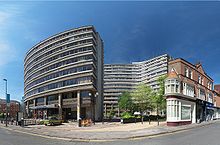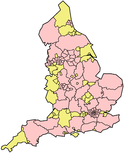- Leicester City Council
-
Leicester City Council is a unitary authority responsible for local government in the city of Leicester, England. It consists of 54 councillors, representing 22 wards in the city, overseen by a directly elected mayor. It is currently controlled by the Labour Party and has been led by Mayor Sir Peter Soulsby since his election on 6 May 2011. The main council building is the New Walk Centre, but council meetings are held in the 19th century Town Hall.
As a unitary authority, the council is responsible for running nearly all local services in Leicester with the exception of the Leicestershire Fire and Rescue Service and Leicestershire Constabulary which are run by joint boards with Leicestershire County Council and Rutland County Council.
Contents
History
The Council traces its roots to the Corporation of Leicester, and before then to the Merchant Gild and the Portmanmoot. The Portmanmoot consisted of 24 Jurats, elected from the burgesses (members of the Gild Merchant, or freemen), along with two bailiffs, and a clerk. It appears to have existed before the Norman Conquest in 1066. In 1209, the lead member of the Portmanmoot, the Alderman, became known as a mayor. The Gild Merchant and the Moot overlapped in membership and had probably become effectively merged in the 14th century. Membership of the Twenty-Four appears to have been by co-option, chosen by themselves.
Traditionally, the general populace attended some meetings of the Moot and Guild, but this was restricted to burgesses in 1467. Later, in 1489, this changed to a system where the Mayor and the Twenty-Four chose Forty-Eight burgesses to represent the others, and the Twenty-Four and the Forty-Eight would govern jointly.
After doubts as to the ability of the Moot and Gild to hold property arose in the 16th century, the Corporation was formed, replacing the Gild and Portmanmoot, in 1589. A second charter was granted in 1599, reconfirming this, to The Mayor, Bailiffs and Burgesses of the Borough of Leicester. The 24 Jurats became known as the Aldermen of the Corporation, and the 48 other Burgesses as the Common Council. The members of the Corporation chose the burgesses to send to the House of Commons.
The Corporation, as with most English municipal corporations, continued effectively unreformed until the Municipal Reform Act of 1835, although the freemen in general obtained the right to participate in the election of MPs after the Restoration. The Municipal Reform Act replaced the existing system of co-option for members of the council with elections by rate-payers. This led to a prolonged spell of Liberal control of the council.
Leicester became, in 1889, under the Local Government Act, a county borough. The Corporation was replaced in 1974 under the Local Government Act 1972, with the modern Leicester City Council, a non-metropolitan district council under Leicestershire County Council. Leicestershire County Council's jurisdiction over the City of Leicester was transferred to the City Council on 1 April 1997, making it a unitary authority, as part of the 1990s UK local government reform.
Lord Mayor
The position of Lord Mayor of Leicester is mainly a ceremonial post, and is combined with that of chair of the council. The position is elected yearly by members of the council and rotates. Here is a history of Leicester's Lord Mayors:
- James Thomas (1927–1928)
- Harry Hand (1928–1929)
- William Hincks (1929–1930)
- Harry Carver (1930–1931)
- Walter Wilford (1931–1932)
- Arthur Hawkes (1932–1933)
- William Billings (1933–1934)
- Ernest Grimsley (1934–1935)
- Richard Hallam (1935–1936)
- Arthur Swain (1936–1937)
- Frank Acton (1937–1938)
- Thomas Gooding (1938–1939)
- George Parbury (1939–1940)
- William Joseph Cort (1940–1941)
- Elizabeth Rowley Frisby (1941–1942)
- Sydney Taylor (1942–1943)
- Charles Edward Gillot (1943–1944)
- John Minto (1944–1945)
- Charles Edward Worthington, C.B.E. (1945–1946)
- William Henry Smith (1946–1947)
- John Newton Frears (1947–1949)
- John William Wale (1949–1950)
- Alderman Frederick Ernest Oliver (1950–1951)
- Aderman Thomas Rowland Hill (1951–1952)
- Alderman Geoffrey Morris Barnett (1952–1953)
- Alderman Charles Robert Keene (1953–1954)
- Alderman Cecil Herbert Harris (1954–1955)
- Alderman Samuel Cooper (1955–1956)
- Alderman Alfred Harkyard (1956–1957)
- Alderman Frederick John Jackson (1957–1958)
- Alderman Sidney Brown (1958–1959)
- Alderman Bertram Powell (1959–1960)
- Alderman Dorothy Russell (1960–1961)
- Alderman May Goodwin (1961–1962)
- Alderman Harold Heard (1962–1963)
- Alderman Constance Elizabeth Jackson (1963–1964)
- Alderman Archibald Henry William Kimberlin (1964–1965)
- Alderman Sidney William Bridges (1965–1966)
- Alderman Mrs Monica Mary Trotter (1966–1967)
- Alderman Sir Mark Henig (1967–1968)
- Alderman Kenneth William Bowder (1968–1969)
- Alderman Edward Marston (1969–1970)
- Alderman George Baldwin (1970–1971)
- Alderman Percy Watts (1971–1972)
- Alderman Herbert Stanley Tomlinson (1972–1973)
- Councillor Clarence Arnold Wakefield (1973–1974)
- Councillor Mrs Anne Irene Pollard (1974–1975)
- Councillor Mrs Lily Roma Marriott J,P. (1975–1976)
- Councillor Bernard Toft (1976–1977)
- Councillor Albert Turner Baker (1977–1978)
- Councillor Albert Sylveter Watson (1978–1979)
- Councillor William Henry Scotton (1979–1980)
- Councillor Herbert Henry Sowden (1980–1981)
- Councillor Archibald Berridge (1981–1982)
- Councillor William Page (1982–1983)
- Councillor George Billington (1983–1984)
- Councillor Michael Cuffllin (1984–1985)
- Councillor Mrs Janet Setchfield (1985–1986)
- Councillor Sydney St.John Phipps (1986–1987)
- Councillor Gordhan Parmar (1987–1988)
- Councillor Guy Collis (1988–1989)
- Councillor David Anthony Taylor (1989–1990)
- Councillor Peter Kimberlin (1990–1991)
- Councillor Colin Grundy (1991–1992)
- Councillor Robert Wigglesworth (1992–1993)
- Councillor Henry Dunphy (1993–1994)
- Councillor Margaret Bell (1994–1995)
- Councillor Michael Johnson (1995–1996)
- Councillor Culdipp Bhatti (1996–1997)
- Councillor Raymond Flint (1997–1998)
- Councillor John Mugglestone (1998–1999)
- Councillor Phil Swift (1999–2000)
- Councillor Mrs Barbara Chambers (2000–2001)
- Councillor John Allen (2001–2002)
- Councillor Maggie Bodell-Stagg (2002–2003)
- Councillor Ramnik Kavia (2003–2004)
- Councillor Piara Singh Clair (2004–2005)
- Councillor Mary Draycott (2005–2006)
- Councillor Paul Westley (2006–2007)
- Councillor Gary G Hunt (2007–2008)
- Councillor Manjula Sood (2008–2009)
- Councillor Roger Blackmore (2009–2010)
- Councillor Colin Hall (2010-2011)
- Councillor Robert Wann (Acting Lord Mayor April/May 2011)
- Councillor Robert Wann (2011-2012)
Hall served as Lord Mayor for 2010-11 but was the only Lord Mayor to resign from the office on 30 April 2011. The then Deputy-Lord Mayor Wann served as Acting Lord Mayor until he himself was elected as Lord Mayor for 2011-12 on 26 May 2011.
Wards
The City is divided into various electoral wards, each of which returns two or three councillors, using the bloc voting system, as follows
Ward Councillors Notes Abbey 3 from Abbey Park up to Stocking Farm and Mowmacre Hill Aylestone 2 Beaumont Leys 3 Belgrave 2 the northern half of the Belgrave area Braunstone Park and Rowley Fields 3 including most of Braunstone Castle 3 city centre, Southfields, Clarendon Park Charnwood 2 Northfields, around Charnwood Street Coleman 2 Crown Hills and North Evington, around Coleman Road Evington 2 Eyres Monsell 2 Fosse 2 Freemen 2 Knighton Fields and the Saffron estate Humberstone and Hamilton 3 including Nether Hall Knighton 3 Latimer 2 the southern half of the Belgrave area New Parks 3 Braunstone Frith Rushey Mead 3 Spinney Hills 3 including parts of Highfields and Evington Valley, and the St Matthew's estate Stoneygate 3 also including parts of Highfields Thurncourt 2 Thurnby Lodge, around Thurncourt Road Westcotes 2 Western Park 2 The current ward boundaries were adopted for the 2003 local elections. [3] Prior to this, there had been 28 wards, each electing 2 members. Wards that had existed and been abolished were Crown Hills, East Knighton, Mowmacre, North Braunstone, Rowley Fields, Saffron, St Augustine's, West Humberstone, West Knighton and Wycliffe.
Political control
The Council had been under the control of the Labour Party from 1979 until the 2003 local elections, where no overall control was established. Labour regained control in 2007 and consolidated its position in 2011.
In December 2010 the Council voted to introduce a directly elected mayor with effect from May 2011. On 5 May 2011 Sir Peter Soulsby was elected to the post with 55% of the vote on the first ballot. He will serve for a term of four years.
The results at the 2011 Council Elections were:
Party Seats[1] Labour 52 Conservative 1 Liberal Democrat 1 Veejay Patel was the Leader of the Council until May 2011, having replaced Ross Willmott on 25 March 2010. Councillor Willmott served for three spells as Leader: from May 1999 to May 2003; from November 2004 to May 2005; and from May 2007 to March 2010.
The period of minority administration came about due to the collapse of the Liberal Democrat-Conservative coalition in November 2004 [4], when the council was in a state of no overall control following the 2003 elections. The coalition regrouped in 2005, but was later hit by Liberal Democrat infighting, leading to the creation of the splinter 'Focus Team' group which worked with Labour in opposition. Labour returned to power with a landside victory in 2007 and consolidated its position still further in May 2011. Ross Grant is the only remaining Conservative Councillor. Nigel Porter is the only remaining Liberal Democrat Councillor, having defected to the Liberal Democrats from the Conservatives, several weeks prior to the election.
The next Local Election is due to take place on 7 May 2015.[2], although by-elections take place when a seat becomes vacant due to resignation or death of a councillor. As of May 2011, the Council was composed of 53 Labour Councillors (including the City Mayor, who is eligible to take part and vote in Council meetings), 1 Conservative Councillor, and 1 Liberal Democrat Councillor.
Elections
Previous results of elections to the city council:
Overall control Labour Conservative Lib Dem Green 2011 Labour 52 1 1 - 2007 Labour 38 8 6 2 2003 No overall control 20 9 25 - 1999 Labour 30 10 16 - 1996 Labour 41 7 8 - 1995 Labour 45 4 7 - 1991 Labour - - - - 1987 Labour - - - - 1983 Labour - - - - 1979 Labour - - - - 1976 Conservative 21 27 - - 1973 Labour 37 11 - - The May 1996 elections were held out of sequence because of the upcoming unitary authority status, which came into effect on 1 April 1997.
Former leaders include
- Jim Marshall (1973–74)
- Sir Peter Soulsby (1981–1994, 1995–99, current directly elected mayor)
- Roger Blackmore 2003-04 and 2005-07
- Ross Willmott (1999-2003, 2004-05, 2007-2010 stood down to run for Parliament)
- Veejay Patel (2010-2011)
References
External links
Categories:- Leicester
- Unitary authority councils of England
Wikimedia Foundation. 2010.


